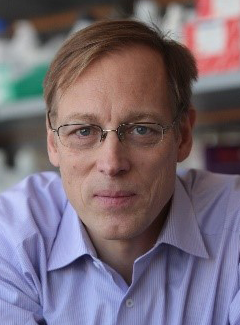Eric A. Hendrickson PhD
Primary Appointment
 Medicine: Hematology and Oncology
Medicine: Hematology and Oncology
Contact
Division of Hematology & Oncology
Po Box 800716
Charlottesville, VA 22908
Email: duk9mc@virginia.edu
EDUCATION AND TRAINING
- BA, Chemistry, University of North Carolina at Chapel Hill, Chapel Hill, NC
- PhD, Biological Chemistry, Harvard Medical School, Boston, MA
- Postdoc, Molecular Immunology, Dana Farber Cancer Institute and Harvard Medical School, Boston, MA
My objective is to understand the molecular and biochemical mechanisms of mammalian DNA double-stranded break (DSB) repair, particularly emphasizing using human somatic cells in culture. The importance of DNA DSB repair is underscored by many human cancer predisposition diseases, such as Nijmegen chromosome breakage syndrome, ataxia telangiectasia, and Fanconi’s anemia, which are caused by defects in DNA DSB repair. The high cancer rate and immunological defects associated with these and other human diseases, such as Dyskeratosis congenita, suggest that generalized DNA DSB repair is critical for other important biological processes, including immune function and telomere maintenance. Our primary experimental model system uses state-of-the-art gene targeting techniques in human cell lines in culture to assess the null phenotypes of these genes in the context of different genetic backgrounds. At the core of our research is the belief that identifying and characterizing the genes and protein factors involved in DSB repair will provide insight into the general mechanisms of DNA recombination and repair and telomere maintenance.
I have been in science for 48 years. I worked for three years at the University of North Carolina at Chapel Hill as an undergraduate honors research student looking at the impact of chemical carcinogens on regenerating rat liver. This work sparked an interest in DNA replication, which was the topic of my subsequent PhD work at Harvard Medical School in the laboratory of Dr. Melvin DePamphilis. I then switched fields to molecular immunology and worked in the laboratory of Dr. David Weaver at the Dana Farber Cancer Institute. I intend to spend the rest of my career studying V(D)J recombination, which is the focus of my post-doctoral work. As fate would have it, in the last year of my studies, I discovered that one of the V(D)J factors (DNA-PKcs) I was studying was a general DNA DSB protein. This altered my professional interests, and upon obtaining my own position at Brown University, I straddled both the V(D)J recombination and DNA DSB repair fields. Over the years, my laboratory has focused much more on the DNA DSB repair aspects, although we still “dabble” in molecular immunology. Two decades ago, I became obsessed with the fact that there was a worldwide lack of human patients containing mutations in our “favorite” DSB genes. We tried to understand what these genes were doing by combining gene-targeting technology (the bread and butter of mouse geneticists) with human somatic cell genetics. This proved to be quite successful, and now, a portion of my laboratory also works on the mechanism of gene targeting. Thus, my laboratory can be broken down into fourths: DNA recombination, DNA DSB repair, telomeres, and gene targeting, and research into these areas often seems to overlap and synergize.
Training Credentials: Over the decades, 62 undergraduate students have worked in my laboratory. The overwhelming majority (90%) of those students have gone on to either medical or graduate schools. There are currently two Ph.D. students in my laboratory (I’m co-mentoring both students). Twenty students have already received their doctorate. One of those students was lured from his tenured position at the NIH to be the director of the Molecular Biology division at Ulsan National Institute of Science and Technology in Ulsan, Korea. Two other students are now tenured full professors (at the University of Texas-San Antonio and at Drew University), one is a tenured Associate professor (University of Pittsburgh), four are research professors at various academic institutions (Xavier University, Pontificia Universidad Catolica del Peru, University of Texas-Southwestern, City University of New York) seven are working in industry (at Celera, Athena Diagnostics, AbeXXa, Cytivia, eGenesis, Genmab and Rebotix). Five are doing post-doctoral work (at the University of North Carolina-Chapel Hill, Northwestern University, and three at the University of Minnesota). In addition, I have had nine post-doctoral fellows work in my laboratory. One is still working with me. The other eight have all gone on to productive careers (except one person, who is untimely deceased): two are now teaching (at the Georgetown College of Medicine and St. Olaf’s College), two are engaged in a second post-doctoral training position at the University of Minnesota, one is engaged in a second post-doctoral training position overseas, one has assumed a principal investigator position in industry with Assure Rx Health, and one is a Research Assistant Professor at City University in NY. Thus, in general, I feel that I have been able to provide an environment that encourages and fosters professional development.
1 R01 CA266524
Hendrickson (PI)
08/01/2022—07/31/2027
POLQ- and CtIP-regulated telomere fusions and translocations are involved in early events in carcinogenesis.
1 R21 AG077174
Hendrickson (PI)
12/01/2022—11/30/2024
Mechanism of radial chromosome formation in human premature aging syndrome cells.
Research Team

Mohammad Ahmad (fall 2024): undergrad
Richard Bowman (2023-present): p-doc
Kendall Bromley (spring 2023): grad student
Elizabeth Dudley (2023-present): research tech
Jonathan Leotona (fall 2024): undergrad
Emilie McCaskill (summer 2024-present): undergrad
Moriam Munni (fall 2024): grad student
Brian Ruis (2005-present): research associate
Clara Szlyk (fall 2024): undergrad
Emma Weaver (fall 2023-present): undergrad
Danielle Wuerdeman (2024-present): research tech
Shuwen Zhan (fall 2023): grad student
